
The New York Times once worked with thousands of advertisers, but it’s now narrowed its focus to the top 100 global brands.
“The business is shrinking in terms of the overall number of advertisers, as there are more places to do longtail advertising,” said Sebastian Tomich, global head of advertising and marketing solutions at The New York Times.
Its strategy, along with a focus on driving reader subscriptions, has created opportunities for the Times to develop custom partnerships with brands. What often start as one-off projects grow into recurring relationships across branded content and experiential and social media marketing.
“The products are full-suite strategy and creative,” Tomich said. “If we can stabilize the media business but also develop new lines of business, then we have a growing ad business.”
Working more closely with advertisers helps grow the Times’ subscription business, as it encourages the 167-year-old company to explore new media formats from augmented reality (AR) to 360 video. The Times has more than 3 million digital subscribers, it announced in November 2018.
“The subscription business allows us to tell an advertiser a story that’s more premium in the market,” Tomich said. “We’re seeking those high-quality products and advertisers. In the future, you will need that to survive.”
As custom executions become core for the Times, programmatic isn’t as much the focus. While the company sells through programmatic guaranteed and private marketplace deals, it steers clear of the open exchange – mainly because it can.
“We are a premium product,” Tomich said. “Open market programmatic doesn’t align with that.”
He spoke with AdExchanger.
AdExchanger: What new media is the Times focusing on this year and what’s the opportunity for brands?
SEBASTIAN TOMICH: We did a lot of AR work last year. We got it into our app, so you can read a story and elegantly scroll through the AR experience. And we created lighter-weight AR creative ad units to add more scale to our initiatives. We’re expanding that into news this year as it becomes cheaper and easier.
Any consumer product you want to see or feel will have a lot of application for that. By no means is it perfect, but I see a lot of advertiser interest.
Are consumers interested in reading news with AR integrations?
Not on an everyday basis. It works for tentpoles. We did a huge [activation] for the Olympics. It also works for big news events like the California wildfires, where you want to see its scale. Any national disaster [or] war reporting has a huge application. There’s still a use case barrier with having to pull out your phone and load it, but we’ll get there.
How much of the Times’ revenue comes from your agencies HelloSociety and Fake Love?
Both had amazing years. As marketers become more automated, they view strategy and creative as a free-for-all for media companies, agencies and consultancies. It’s up to us to build the capabilities and bring the talent in-house. That’s where the business is heading.
Has that created tension with agency buyers?
We used to talk about that all the time, but just as our business is transforming, agency business is transforming. I think agencies are more focused on competing with consultancies than publishers nipping away at their business.
How do you see programmatic fitting in with all of the custom stuff that you’re doing?
I guess I don’t. We’re very in favor of direct programmatic. Overall, we’re focused on developing large partnerships with brands.
We see more agencies coming to us as they seem to be freaking about their programmatic future. A lot of them went all-in with trading desks. Every agency seems to be course-correcting around transparency and needs to be closer with publishers to discuss things like fees.
The Times had had huge success last year with its podcast “The Daily.” What’s your audio strategy this year?
As an ad format it works really well. It’s opt-in and disruptive. Digital ads weren’t disruptive enough. We can skip, and it created this mindset that digital advertising was a waste. The challenge is now that publishers realize that the ads work, we’re going to enter this era of audio spam.
The Times’ strategy is not about being the first or creating the most. It’s about creating hits that only the Times can create. I predict a strong ad business for two years, and then the same transformation we saw with digital is going to play out with audio. Platforms come in, automate the business and offer more efficient advertising options. [Other] platforms move into consumer models and put [podcasts] behind paywalls and free distribution will go away. Do you want your entire audience on someone else’s platform or do you want to own it?
How is the Times thinking about audience targeting as the privacy landscape changes?
We’re doing very little audience targeting. We’re all about context, but more dimensions outside of putting a business advertiser next to business editorial.
There are other ways in. Emotion is one. Targeting [against] how people feel reading a story and tying in which brands fit has been a big hit. [We’re] trying to figure out topics that go beyond keywords. If you want to be around pharmaceutical drugs and you keyword target “drugs,” that’s going to be a lot of stuff. But if we use machine learning to find stories about the pharmaceutical industry that aren’t tagged, that’s interesting to advertisers.
The inherent tension for the Times is we are very much reporting on concerns around privacy, data and technology. So our initial instinct is to focus on behavior and context [rather] than personal information and audience buying.
This conversation has been edited and condensed.
This post was syndicated from Ad Exchanger.


More Stories
Around the World: Elon Musk’s brand freefallin’ and celebrity splits shine in marketing
Daily Wire Welcomes Perplexity to Advertise on The Ben Shapiro Show
Here’s the Roundup for the Week Ending March 7